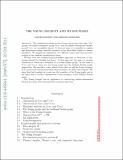| dc.contributor.author | Borodin, Alexei | |
| dc.contributor.author | Olshanski, Grigori | |
| dc.date.accessioned | 2013-10-30T15:46:48Z | |
| dc.date.available | 2013-10-30T15:46:48Z | |
| dc.date.issued | 2013-04 | |
| dc.date.submitted | 2012-09 | |
| dc.identifier.uri | http://hdl.handle.net/1721.1/81879 | |
| dc.description.abstract | The classification results for the extreme characters of two basic “big” groups, the infinite symmetric group S(∞) and the infinite-dimensional unitary group U(∞), are remarkably similar. It does not seem to be possible to explain this phenomenon using a suitable extension of the Schur–Weyl duality to infinite dimension. We suggest an explanation of a different nature that does not have analogs in the classical representation theory. We start from the combinatorial/probabilistic approach to characters of “big” groups initiated by Vershik and Kerov. In this approach, the space of extreme characters is viewed as a boundary of a certain infinite graph. In the cases of S(∞) and U(∞), those are the Young graph and the Gelfand–Tsetlin graph, respectively. We introduce a new related object that we call the Young bouquet. It is a poset with continuous grading whose boundary we define and compute. We show that this boundary is a cone over the boundary of the Young graph, and at the same time it is also a degeneration of the boundary of the Gelfand– Tsetlin graph. The Young bouquet has an application to constructing infinite-dimensional Markov processes with determinantal correlation functions. | en_US |
| dc.description.sponsorship | National Science Foundation (U.S.) (NSF-grant DMS-1056390) | en_US |
| dc.description.sponsorship | Simons Foundation (Simons–IUM Fellowship) | en_US |
| dc.description.sponsorship | Russian Foundation for Basic Research (RFBR-CNRS grant 10-01-93114) | en_US |
| dc.description.sponsorship | Universität Bielefeld (project SFB 701) | en_US |
| dc.language.iso | en_US | |
| dc.publisher | Independent University of Moscow | en_US |
| dc.relation.isversionof | http://www.mathjournals.org/mmj/2013-013-002/2013-013-002-002.pdf | en_US |
| dc.rights | Creative Commons Attribution-Noncommercial-Share Alike 3.0 | en_US |
| dc.rights.uri | http://creativecommons.org/licenses/by-nc-sa/3.0/ | en_US |
| dc.source | arXiv | en_US |
| dc.title | The Young Bouquet and Its Boundary | en_US |
| dc.type | Article | en_US |
| dc.identifier.citation | Borodin, Alexei and Grigori Olshanski. "THE YOUNG BOUQUET AND ITS BOUNDARY." Moscow Mathematical Journal 13:2 (2013) Pp.193–232. | en_US |
| dc.contributor.department | Massachusetts Institute of Technology. Department of Mathematics | en_US |
| dc.contributor.mitauthor | Borodin, Alexei | en_US |
| dc.relation.journal | Moscow Mathematical Journal | en_US |
| dc.eprint.version | Original manuscript | en_US |
| dc.type.uri | http://purl.org/eprint/type/JournalArticle | en_US |
| eprint.status | http://purl.org/eprint/status/NonPeerReviewed | en_US |
| dspace.orderedauthors | Borodin, Alexei; Olshanski, Grigori | en_US |
| dc.identifier.orcid | https://orcid.org/0000-0002-2913-5238 | |
| mit.license | OPEN_ACCESS_POLICY | en_US |
| mit.metadata.status | Complete | |
